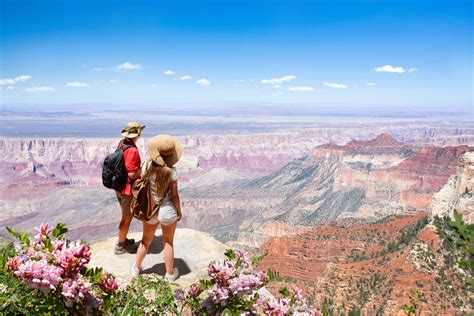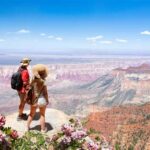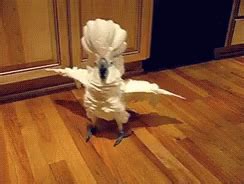
A group of hikers in the Grand Canyon National Park rescued a dehydrated and struggling hummingbird by selflessly feeding it sugar water, offering a heartwarming display of compassion and igniting a beacon of hope for wildlife enthusiasts.
The hikers encountered the tiny bird near the bottom of the canyon, visibly weak and in distress. Recognizing the hummingbird’s dire condition, they pooled their resources and ingenuity to provide it with a life-saving dose of sugar water, a crucial energy source for these nectar-dependent creatures.
“The little guy was in rough shape,” one of the hikers, identified as James Sowerby, told Yahoo News. “We knew we had to do something.”
Sowerby and his companions, during a multi-day hiking expedition, were approximately six miles into their trek when they spotted the hummingbird. Recognizing that the bird’s survival hinged on immediate intervention, the group improvised a feeding apparatus using readily available materials. “We mixed some sugar with water and offered it to him,” Sowerby explained. “At first, he was hesitant, but then he started drinking, and it was like watching him come back to life.”
The hikers continued to provide the hummingbird with sustenance over a period of several hours, allowing it to regain its strength. They eventually watched as the rejuvenated bird took flight, disappearing into the vast expanse of the Grand Canyon. The act of kindness has resonated widely, with images and stories of the rescue spreading rapidly across social media platforms.
“It’s a reminder that even small acts of compassion can make a big difference,” said Sarah Thompson, a wildlife rehabilitator with the Arizona Game and Fish Department, commenting on the incident. “Hummingbirds are vital pollinators, and every individual counts.”
This incident underscores the importance of responsible hiking practices and the potential for human intervention to positively impact wildlife in distress. It also highlights the delicate balance of the Grand Canyon ecosystem and the challenges faced by its inhabitants, especially during periods of extreme heat and drought. The hikers’ selfless actions serve as an inspiration, demonstrating how a quick response and a caring attitude can save a life and foster a greater appreciation for the natural world.
The Grand Canyon, a UNESCO World Heritage site, attracts millions of visitors annually. Its unique geological formations and diverse ecosystems provide habitat for a wide range of plant and animal species, including several hummingbird varieties. These tiny birds play a critical role in pollinating native plants, contributing to the overall health and biodiversity of the canyon environment.
The rescue of the hummingbird has not only captured the hearts of many but has also sparked a broader conversation about wildlife conservation and the importance of protecting natural habitats. Experts emphasize that even simple actions, such as providing water sources for wildlife during dry periods and avoiding the use of pesticides, can significantly benefit these vulnerable creatures.
The story of the Grand Canyon hikers and the rescued hummingbird is a testament to the power of human compassion and the interconnectedness of all living things. It serves as a poignant reminder that even in the most remote and challenging environments, acts of kindness can flourish and make a lasting impact.
Expanded Details and Context:
The specific species of hummingbird involved in the rescue was not definitively identified in the initial reports, though experts suggest it was likely one of the common species found in the Grand Canyon region, such as the Black-chinned Hummingbird (Archilochus alexandri) or the Anna’s Hummingbird (Calypte anna). Identifying the specific species would require more detailed observation of its physical characteristics, such as plumage patterns and size.
Hummingbirds are among the smallest birds in the world and are known for their remarkable agility and hovering abilities. They have extremely high metabolic rates, requiring them to consume large amounts of nectar to fuel their energy-intensive activities. This makes them particularly vulnerable to dehydration and starvation, especially in harsh environments like the Grand Canyon.
The Grand Canyon’s ecosystem presents unique challenges for hummingbirds. The arid climate and limited water sources can make it difficult for them to find the resources they need to survive. Additionally, the extreme temperature fluctuations between day and night can further stress these tiny creatures.
Hikers who encounter wildlife in distress should exercise caution and prioritize the animal’s safety. It is generally recommended to observe the animal from a distance and avoid approaching it unless it is clearly in need of assistance. If intervention is necessary, it should be done carefully and with the animal’s well-being in mind. In many cases, contacting local wildlife authorities or a qualified wildlife rehabilitator is the best course of action.
The Arizona Game and Fish Department provides guidance and resources for hikers who encounter wildlife in distress. Their website offers information on identifying common wildlife species and reporting injured or orphaned animals. They also work with a network of licensed wildlife rehabilitators who are trained to care for injured and sick animals.
The Grand Canyon National Park also has specific regulations regarding interactions with wildlife. Visitors are prohibited from feeding wildlife, as this can disrupt their natural behaviors and make them dependent on humans. However, providing temporary assistance to an animal in distress, such as offering water to a dehydrated hummingbird, may be considered an exception under certain circumstances.
The long-term implications of climate change on the Grand Canyon’s ecosystem are a growing concern. Rising temperatures and prolonged droughts are expected to exacerbate the challenges faced by wildlife, including hummingbirds. Conservation efforts aimed at protecting water sources and restoring native plant communities are crucial for ensuring the long-term survival of these species.
The act of kindness displayed by the Grand Canyon hikers has inspired many to take a more active role in wildlife conservation. Individuals can contribute by supporting local conservation organizations, volunteering their time, and making simple changes in their daily lives to reduce their impact on the environment.
The widespread media coverage of the hummingbird rescue has also raised awareness about the importance of responsible tourism. Visitors to national parks and other natural areas should be mindful of their impact on the environment and take steps to minimize their disturbance to wildlife. This includes staying on designated trails, avoiding the use of pesticides and herbicides, and properly disposing of trash.
The story of the Grand Canyon hikers and the rescued hummingbird serves as a powerful reminder of the interconnectedness of humans and nature. It demonstrates that even small acts of compassion can have a significant impact on the lives of other creatures and can inspire others to take action to protect the environment.
The sugar water solution provided by the hikers was likely a simple mixture of granulated sugar and water, typically in a ratio of 1 part sugar to 4 parts water. This mixture closely mimics the natural nectar that hummingbirds feed on and provides them with a quick source of energy. It is important to avoid using honey or artificial sweeteners, as these can be harmful to hummingbirds.
The hikers’ ability to recognize the hummingbird’s distress and respond quickly was crucial to its survival. Dehydration can quickly become life-threatening for hummingbirds, especially in hot and dry environments. By providing the bird with sugar water, the hikers were able to rehydrate it and give it the energy it needed to recover.
The success of the rescue highlights the importance of preparedness when hiking in remote areas. Carrying a small amount of sugar and water can be a lifesaver for wildlife in distress. Additionally, it is essential to be aware of the potential hazards to wildlife and to take steps to minimize one’s impact on the environment.
The story of the Grand Canyon hummingbird rescue has resonated with people around the world, inspiring acts of kindness and promoting greater awareness of wildlife conservation. It serves as a powerful reminder that even small actions can make a big difference and that everyone has a role to play in protecting the natural world. The event demonstrates the significance of human interaction with nature, where compassion and immediate action can preserve wildlife struggling for survival in harsh environments.
The broader implications of this event call attention to the challenges faced by hummingbirds and other pollinators due to habitat loss, pesticide use, and climate change. Conservation efforts aimed at protecting and restoring pollinator habitats are crucial for ensuring the long-term health of ecosystems and the sustainability of agriculture. Supporting local organizations and advocating for policies that protect pollinators are important steps that individuals can take to contribute to these efforts.
The Grand Canyon itself provides a unique backdrop to this story. Its vastness and rugged terrain emphasize the vulnerability of even the smallest creatures within its boundaries. The hikers’ act of compassion stands in stark contrast to the often-unforgiving nature of the canyon, highlighting the potential for humans to make a positive impact on the environment.
Furthermore, the event underscores the importance of education and awareness. By sharing their story, the Grand Canyon hikers have inspired others to learn more about hummingbirds and other wildlife and to take steps to protect them. Increased awareness can lead to more responsible behavior and a greater appreciation for the natural world.
In conclusion, the story of the Grand Canyon hikers and the rescued hummingbird is a heartwarming tale of compassion and conservation. It serves as a reminder of the interconnectedness of all living things and the importance of taking action to protect the environment. The event has inspired many to get involved in wildlife conservation and to make a positive impact on the world around them. The swift actions and generous spirit shown by the hikers demonstrate how human interventions, when thoughtfully and compassionately applied, can dramatically change the fate of wildlife in vulnerable situations.
FAQ Section:
1. What exactly did the hikers do to help the hummingbird?
The hikers found a dehydrated and weak hummingbird near the bottom of the Grand Canyon. Recognizing its distress, they mixed sugar with water and offered it to the bird in an improvised feeder. They continued to provide the hummingbird with sustenance for several hours, allowing it to regain its strength before it flew away. According to James Sowerby, one of the hikers, “We mixed some sugar with water and offered it to him. At first, he was hesitant, but then he started drinking, and it was like watching him come back to life.”
2. Why was the hummingbird in such distress?
Hummingbirds have extremely high metabolic rates and require frequent feeding to maintain their energy levels. The arid climate and limited water sources in the Grand Canyon can make it difficult for them to find enough food and water, especially during periods of extreme heat. Dehydration and starvation are common threats to hummingbirds in this environment.
3. What species of hummingbird was it?
The specific species of hummingbird was not definitively identified in the initial reports. However, experts suggest that it was likely one of the common species found in the Grand Canyon region, such as the Black-chinned Hummingbird (Archilochus alexandri) or the Anna’s Hummingbird (Calypte anna). A more detailed examination of its physical characteristics would be needed for precise identification.
4. Is it safe for hikers to feed wild animals?
Generally, it is not recommended to feed wild animals, as this can disrupt their natural behaviors and make them dependent on humans. However, providing temporary assistance to an animal in distress, such as offering water to a dehydrated hummingbird, may be considered an exception under certain circumstances. It is important to exercise caution and prioritize the animal’s safety. Contacting local wildlife authorities is generally the best first step.
5. What can I do to help hummingbirds and other wildlife?
There are many ways to help hummingbirds and other wildlife. You can support local conservation organizations, volunteer your time, and make simple changes in your daily life to reduce your impact on the environment. This includes providing water sources for wildlife during dry periods, avoiding the use of pesticides, and planting native plants that provide food and shelter. The Arizona Game and Fish Department and the Grand Canyon National Park websites provide valuable resources for wildlife conservation.
6. What is the proper ratio of sugar to water for feeding hummingbirds?
The recommended ratio is 1 part granulated white sugar to 4 parts water. It’s essential to mix the solution thoroughly and avoid using honey, artificial sweeteners, or any other additives, as these can be harmful to hummingbirds. Boiling the water before mixing can help dissolve the sugar and prevent mold growth.
7. Are there any specific risks associated with hiking in the Grand Canyon that impact wildlife?
The Grand Canyon’s extreme temperatures, arid climate, and limited water sources pose significant challenges to wildlife. Hikers should be aware of these conditions and take steps to minimize their impact on the environment. Staying on designated trails, packing out all trash, and avoiding disturbing wildlife are crucial. Climate change is exacerbating these challenges, leading to more frequent and severe droughts that further stress the ecosystem.
8. How does this incident highlight the importance of conservation efforts?
This incident underscores the importance of protecting natural habitats and conserving water resources. Hummingbirds and other pollinators play a vital role in maintaining healthy ecosystems. Conservation efforts aimed at preserving their habitats and ensuring access to food and water are essential for their long-term survival. The hikers’ actions demonstrate that even small acts of compassion can contribute to these efforts.
9. What actions can tourists take to ensure they are responsible when visiting national parks like the Grand Canyon?
Tourists can take several actions to be responsible visitors: adhere to park regulations, stay on marked trails to protect vegetation and wildlife habitats, avoid feeding animals to prevent dependence on humans, properly dispose of waste to keep the park clean, and respect wildlife by observing from a safe distance. Educating oneself about the park’s ecosystem and the challenges it faces can also contribute to a more responsible visit.
10. How has social media amplified the impact of the hummingbird rescue?
Social media has played a significant role in amplifying the story of the hummingbird rescue. The images and stories shared online have reached a wide audience, raising awareness about the challenges faced by wildlife and inspiring others to take action. The viral nature of the story has also helped to promote responsible tourism and wildlife conservation efforts. The shared content serves as a powerful example of how individual acts of kindness can have a broader impact when disseminated through social media platforms.









